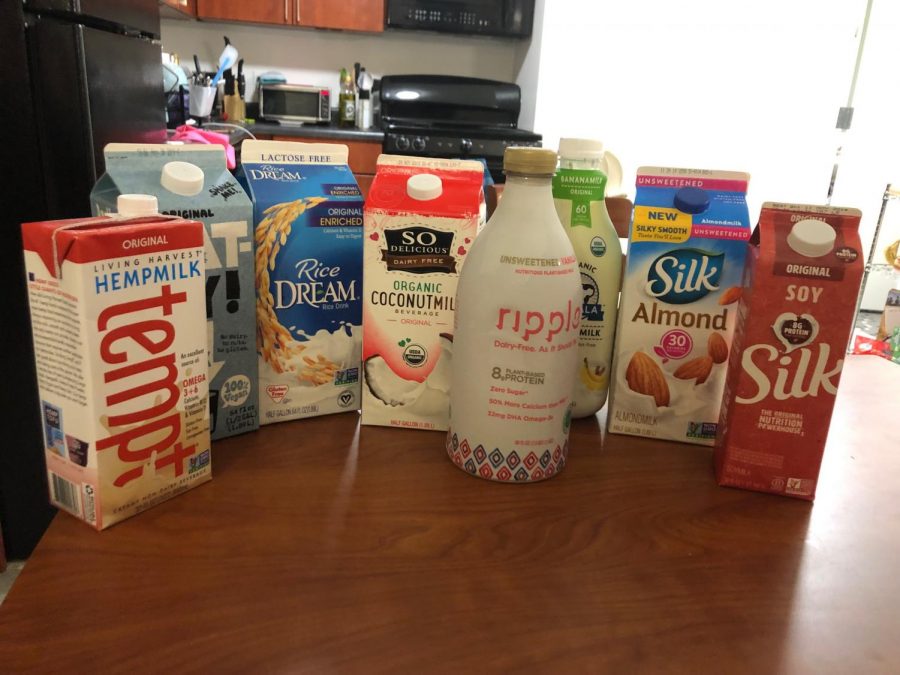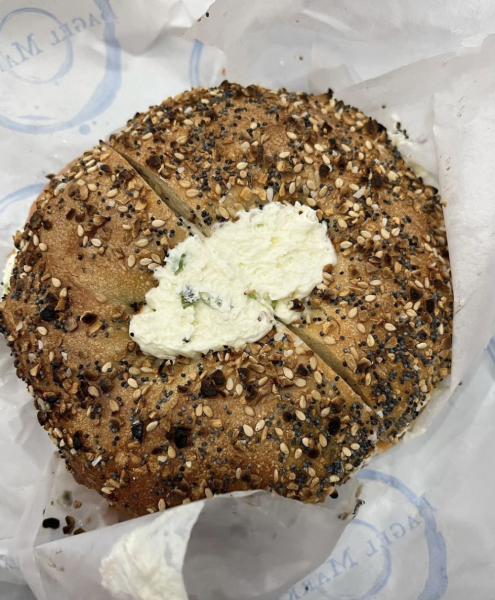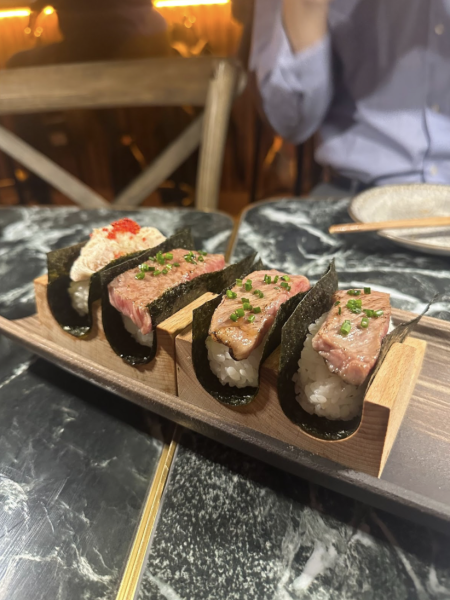Drink Responsibly: Plant-Based Milk
You hear it when someone says their Starbucks order; you see it when you stroll down the grocery store aisle; they’re popping up more and more — non-dairy milks. What began as a narrow market for those with lactose intolerance has blossomed into a growing industry of plant-based milks.
With so many, how can one know which is best? The Ram picked out eight plant-based milks — almond (unsweetened), soy, coconut, banana, rice, pea, hemp and oat — to compare on the bases of taste, sustainability, affordability and nutrition.
Almond is arguably the most popular plant-based alternative. Sitting at $4.50 per half gallon at Cherry Valley, it can be purchased for as low as $2.99 at Whole Foods. While its popularity and availability are enticing, effects on the environment should be considered — an Oxford study found that a 200 ml glass of almond milk requires 74 liters of water to produce, which is more than a typical shower.
Another demystifying aspect of almond milk is that tree nuts are a common allergen.
Gabe Perez, FCRH ’20, voiced his opinion: “Really watery, tastes like almonds. It’s not milk. I wouldn’t put it in my coffee; it would just ruin it.”
Soy received slightly better reviews. “[It’s] somewhere in between [whole and skim milk],” Justine Engel, FCRH ’20, commented. This renders it a good option for those who prefer dairy milk. A quart of soy milk is available for $3.49 at Cherry Valley and $1.99 at Whole Foods.
Reviews compared coconut milk to tasteless juice. “I just don’t like the idea of pulp in my milk,” Perez said. “That’s why I drink OJ.” A half gallon of So Delicious coconut milk is available for $4.99 at Whole Foods and Cherry Valley.
One of the newest alternatives is Mooala’s banana milk. With real banana puree, cinnamon and no added sugar, it has a 2% milk–consistency and Mooala suggests usage similar to regular milk.
The consensus from the Ram tasters is that it makes for a sweet treat. “It’s a dessert milk,” Katelyn Cody, FCRH ’20, said.
However, banana milk’s fatal flaw is its price — a whopping $6.99 for a 1.5 quart bottle at Whole Foods.
“Rice drink” is another option, a suitable title due to the milk’s thin quality. “We’re really stretching the definition of milk here. That’s not milk; that’s rice water. … I’m gonna give it a zero ’cause it’s not even milk,” said Perez.
However, Engel found positives in the beverage. “It would be okay with cereal, I think,” she said. This is better than skim milk.” But with the most amount of emissions after dairy milk and second to almond milk in water use, it is not the most sustainable option. A half gallon of Rice Dream can be found at Whole Foods for $4.39, as well as at Cherry Valley.
Pea milk is another newcomer, most commonly produced by Ripple. A strong alternative nutritionally, it performed well with students taste-wise. They likened it to a better, creamier, more sustainable version of almond milk. A 1.5-quart container of Ripple’s pea milk is available at Whole Foods for $5.49.
Hemp, while nutritious, was found to taste the worst.
“That’s not milk; that’s a curse,” said Perez. “I cannot believe how bad that tasted. Hemp is diseased.”
Perez and Engel agreed that the drink leaves a “tingling” and “bitter” aftertaste in your throat. It is only available at Whole Foods for $4.39 per quart.
Oat milk, made popular by the Swedish brand Oatly, has found its way into other popular brands such as Silk and Quaker Oats. Oatly’s half gallon of original, fat and nonfat can be purchased at Whole Foods for $4.99 and Cherry Valley for $5.99. Oat proves to be one of the most sustainable options by wasting the least amount of water, according to BBC.
Oat milk received the best reviews from the Ram’s tasters. “That’s the best. Undisputed. … It’s insane how close this is to real milk,” said Perez.
While taste plays a big factor, nutrition is also essential for consumers.
Dairy milk contains large amounts of calcium and protein, and campaigns such as “Got Milk” have encouraged Americans to seek these nutrients.
If you desire a dairy alternative with a close nutritional makeup to regular milk, pea is one of the best options, containing 8 grams of protein, the same as one cup of 2% milk, and almost half of one’s daily recommended calcium intake.
Soy milk also boasts a high intersection between calcium and protein, with 30% of one’s recommend calcium and 7 grams of protein.
But, as Engel pointed out during the Ram’s tasting, soy milk has estrogen-mimicking qualities which may be bad for women. According to Mayo Clinic, ingesting more than a “moderate” amount of soy products can put you at risk of hormonally-sensative cancers like breast cancer. While none of these investigations prove causation, consumers may want to consider soy milk’s impact on their hormones before ingesting large quantities.
Other plant-based milks provide varied nutrition in comparison to dairy milk. Almond and hemp have almost no protein but provide an impressive array of other vitamins.
Almond has a comparable amount of calcium to dairy milk, while hemp provides almost half of the recommended daily omega-3. Similarly, oat milk is low in protein and high in sugar content, but fortified with half of one’s vitamin B12 intake as well as 20% of both one’s vitamin A and D recommendations. Banana milk may be the least nutritious option with small amounts of protein, calcium and other vitamins.
An assessment of these plant-based milks may make the switch from dairy milk seem advantageous.
However, it is the ubiquity of dairy milk that often pushes coffee and cereal aficionados to choose it over non-dairy options, especially for a population of students who often prioritize convenience over sustainability. How accessible are these non-dairy options for Fordham students?
Almost all on campus eateries provide one, if not more, non-dairy options. P.O.D. sells a variety of soy and almond milk, including sweetened and flavored varieties. These can be purchased with DCB and used by students who make coffee or eat cereal in their dorms. If supplies are running low at P.O.D., or a student prefers another plant-based milk, Cherry Valley across the street boasts an impressive variety.
They have almond, soy, oat, rice, cashew and coconut as well as variations specifically designed for coffee. If this assortment still does not satisfy plant-based ambitions, the Whole Foods at Columbus Circle, a frequent stop for Rose Hill and Lincoln Center students, is a haven for non-dairy milk.
All options discussed in this article as well as other nut milks not sampled can be purchased here.
Non-dairy milks, although a more dismal array, can also be found at coffee shops, including both BKG and Starbucks on campus and Dunkin Donuts on Fordham Road. Dunkin Donuts offers only almond milk as an alternative, while Starbucks has almond, soy and coconut.
However, students must ask for these non-dairy alternatives at the counter — they are not available in the black thermoses by the sugar.
BKG in Dagger John’s has a comparable number of choices, but is the only eatery on campus where oat milk can be substituted.
The cafeteria, Salt & Sesame and Urban Kitchen also provide almond, soy or both milks as coffee and cereal options.
As we broaden our conception of milk to include liquids made from blended almonds and soaked rice, it can seem daunting to consider which of these options is best.
Some are more sustainable or provide an abundant array of vitamins. Others, as Perez poetically said, “should be burned with fire.”
Try almond milk in your coffee, soy over cereal or banana in your smoothies — none of these are wrong ways to consume plant-based milks if they are decisions made with insight.
Do not simply be a consumer, but an informed one.
Drink milk responsibly.
Copy Chief for Volume 101.

Editor in Chief for Volume 103
Culture Editor for Volume 101, Volume 102.
Rachel Gow is a junior at Fordham College at Rose Hill, majoring in Journalism...












































































































































































































